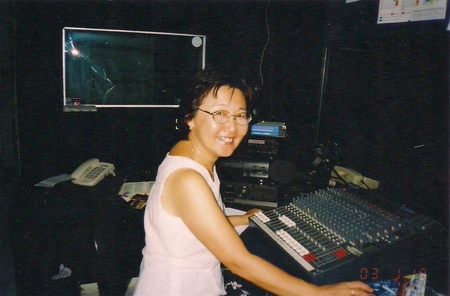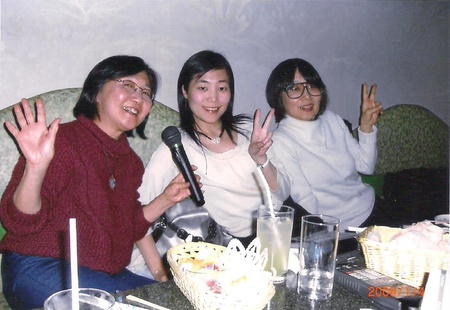When I was eight years old, I attended Japanese language school for a while and the only memory I have of it is Gakugei-kai , when students performed musical numbers and plays for a small audience of parents and teachers. The most graceful girl in the class always took on the coveted role of princess in history and those with musical talent sang traditional children's songs.
I was never chosen to be the princess nor was I good at singing, but there was a song that I really liked – “Mikan no hana saku oka” – and I started rehearsing it at home to, who knows, perform it on Gakugei day- kai . But that was just a wish, as I didn't have the courage to ask the teacher to include me in the cast.
Already at the gym, on Sunday mornings I went with my classmates to Nodojiman , an amateur singing competition that was held before each Japanese film screening at Cine Nippon. One of those times, a colleague took the stage and sang “Itsuki no komoriuta” which she had learned from her grandmother. I was quite excited and started rehearsing some Missora Hibari songs, but this time I also lacked the courage to go on stage and release my voice.
Convinced that I really didn't have a talent for Japanese music, I started listening to the radio daily and caught up with the biggest hits of the time. Paul Anka, Neil Sedaka, Pat Boone, Doris Day and later the Jovem Guarda group, each with their own style, served to rock my sweet teenage dreams.
It was in 1963, when I was in my first year of Science (High School) that something unprecedented happened: for the first time a Japanese singer, Sakamoto Kyu, broke through in the USA with the song “Ue o muite arukoo” (which the Americans called “ Sukiyaki” because it is easier to memorize).
This song was a hit in Brazil and even received a version in Portuguese, but there was a classmate in the class who wanted to sing it in Japanese and soon came to ask me for the lyrics. I was very happy because, among the many Nikkei colleagues (at that time, the proportion of Nikkei students was significant), she must have thought I was “the most Japanese”. Deep down I felt proud of my roots, of being Nikkei.
Then came the time of Bossa Nova, Tropicália, and Japanese music was restricted to the songs that Kayama Yuzo sang in the films in the “Wakadaisho” series.
Time passed and the time of cable TV arrived, when I became a regular viewer of Japan's NHK broadcaster. So I got to know some of the music that the Japanese enjoy, from Enka to J-Pop. It was from there that I defined my musical taste, which focuses on performers as diverse as The Gospellers, Sada Masashi, Hitoto Yo and Tokunaga Hideaki. In particular, I like the lyrics they sing.
In July 2001 I retired and in October of the same year I was invited to produce and present programs about Japanese culture and music on a station in Marília, in the interior of São Paulo. I moved there and spent six years presenting “OHAYO Bom Dia”, a program that provided information, culture, cooking tips and Japanese music of different styles such as children's songs, popular music, songbook classics and gospel music.
The listening public was varied and very loyal. Housewives, children, students who went to school in the afternoon, students who listened during breaks at school, traders, clerks, market traders, seamstresses, taxi drivers, retirees. A lot of people weren't Nikkei or understood Japanese, but they liked the songs. And the general preference were the songs “Kimi to itsumademo” in the voice of Kayama Yuzo and “Ue o muite arukoo” with Sakamoto Kyu which, incidentally, was the opening song of the program. I had chosen it precisely because it was the song that brought out my Nikkei side as a student.
The gospel music produced in Japan is of high quality and whoever listens to it will never forget it. Listeners called to ask for an encore and said: “I don't understand anything, but I feel a lot of anointing so I want to hear it one more time”.
The program came to an end in November 2007, because the following year I went to Japan to stay for four years.
But the time on the radio was a precious time to bring back a lot of good things. Thanks to this activity, I began to remember episodes that were dormant in my memory and that go back to the time when my parents were alive. And even today, remembering it squeezes my heart with longing and a feeling of gratitude.
Until then I thought that Japanese music hadn't influenced our family. When we didn't have TV yet, after dinner we listened to the radio and I vaguely remember it was a Japanese popular music program. I mean, while my mother was washing dishes, I was doing homework and my father was reading the newspaper, the voices of Mihashi Michiya, Shimakura Chiyoko and Tsuruta Koji echoed through the room. They were sounds as familiar as the tap of the knife cutting vegetables and the sound of the Singer machine sewing my little girl's dresses.
My father worked on the other side of the city, but every now and then he would go down to Liberdade, go into the only store that sold records from Japan and come home announcing: “This is a new singer, but they say he's very good”.
My mother said that her father, my grandfather, despite being quiet and serious, one day decided to buy a chikuonki to listen to Shoji Taro and others. And that gramophone (remember the dog with the ear on the horn?) bought with the sweat of his brow ended up becoming the biggest attraction on Sundays, when everyone forgot about their daily work in the fields and enjoyed the melodies of the land they had left behind. back.
Another incredible thing was when my mother told me that my father's hobby when he was young was playing the harmonica! And, as I write this now, I think I once heard my father playing Moshi moshi kameyo ... Or am I fantasizing?
In 2005 I took a trip to Japan and one of the goals was to attend The Gospellers' 10th Anniversary show at Nippon Budokan in Tokyo, which was an unforgettable performance.
Even though I liked Japanese popular music, I had never been to a karaoke in Brazil, but when I returned to Japan in 2009, my friends took me to a Karaoke Box for the first time.
It was really fun and interesting! When it came to choosing the song, it was the biggest difficulty, as I didn't even know one of the songs in the relationship! It was a surprise, because I thought I was an expert in kayokyoku 1 ! My friends wanted to help: “Do you know this one…” and they hummed and sometimes I just recognized the melody.
Finally, I chose “Tokyo Kiddo”, one of Missora Hibari’s first hits as a girl, I sang it and the class was amazed! How do you know this song?!? I didn't even remember it anymore!
This is my relationship with Japanese music: very old, from when I was in my mother's womb and listened to Nen-nen-kororiyo okororiyo 2 ... There was, yes, a time when we were distant, but the relationship continues and it gets narrower and narrower as the years go by.
Nowadays it seems like it's out of fashion to listen to CDs, but I have my favorites and when I miss Japan I listen to them and dream...
Grades
1 Japanese popular music
2 Lullaby dating from the Edo Era (1603-1868)
© 2018 Laura Hasegawa-Honda






